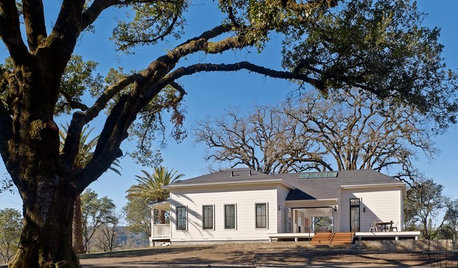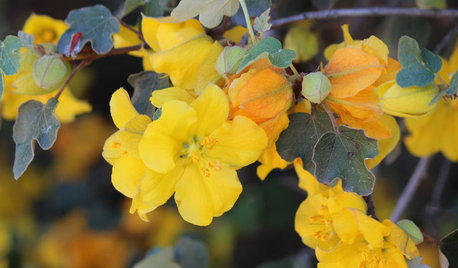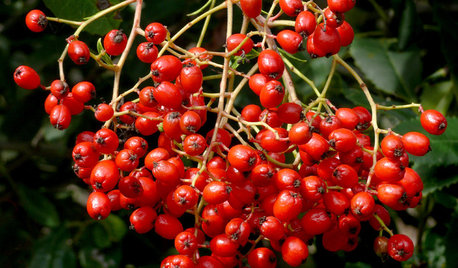Not only in California ...
roselee z8b S.W. Texas
8 years ago
Featured Answer
Sort by:Oldest
Comments (34)
miradus01
8 years agoPKponder TX Z7B
8 years agoRelated Discussions
How do you irrigate a slope?
Comments (12)Diane I ran regular hoses from faucets to weepers. I'm not quite clear on your bed specifics, but depending on what you've got in terms of garden borders, hedges, and other cover plants you could try the following strategy. I had a client with a slope behind her house and a narrow fenced bed running along the side property. The faucet was on the side of the house. We ran a discreetly-colored hose through the narrow bed and down to the weepers. I staked it, threw mulch over it, and left it in place. I coiled the other end of the hose and stuffed it behind some shrubs. When needed, it was easy to uncoil those few feet and hook it up to the water source. When not it use, it was virtually invisible. I also peeled back lawns or dug under pathways, ran PVC through shallow trenches, and snaked hoses through the pipes. I only recommend this method for short distances. Does this help at all, Diane? Thoughts from Catspa or Hoovb? Carol...See MoreRegional Garden Diversity
Comments (3)Ratibida columnifera- I just can't get over those cute little cones. They really DO look like hats! I'm waiting for mine to start blooming this year. Native to quite a few different states. My neighbor has a patch of those orange ditch lilies. And while I'm not planning on adding them in my garden, they ARE handy for filling in those hard to landscape spots. Not to mention that lovely pop of color when they bloom. Baptisia: While I've never seen it in NY, the plant database claims it's native to this and many other states. Now, if it would just GROW for me! Also, I have a handful of different gaillardias right now. I believe all are native to some portion of the southwestern US. Love them for their drought tolerance. Tracy...See MoreEbbe Square Drain
Comments (20)This is an older post but how are people's Ebbe Drains holding up? The Ebbe Drain has a plastic flange and the sales people at the kitchen and bath showroom said they are "crap". I have already purchased them and paid for the heavy duty decorative cover which was not inexpensive and the salespeople recommended that I rip them out if possible. They have not been tiled in yet but have been installed. Hope to hear some more positive reviews, they have a lifetime warranty so I'm thinking they aren't "crap" and should be fine. Any opinions on the durability of the flange? Thank you!...See Morei met my sink today!
Comments (15)prettttttty sink, coleen! congratulations. how wide is the larger bowl? i always wanted the single bowl so i could soak my giant roasting pan inside ...something i couldn't do with my old ss sink ...but yours looks like it may hold a roaster too. remodelfan: the scratch is on the top of one lip where they had it mounted facing front. i don't see this as a problem as carlos (fabricator guy who i LOVE) is getting the touch up kit from rohl AND we're going to mount it so the side with the scratch faces the rear. the counters will be marble with a double ogee so it may cover it anyway. i love difficult people. it affords the rest of us some pretty great deals....See Moresylviatexas1
8 years agolast modified: 8 years agoroselee z8b S.W. Texas
8 years agolast modified: 8 years agopatty_cakes42
8 years agoroselee z8b S.W. Texas
8 years agolast modified: 8 years agobostedo: 8a tx-bp-dfw
8 years agolast modified: 8 years agomiradus01
8 years agoTxMarti
8 years agolast modified: 8 years agobostedo: 8a tx-bp-dfw
8 years agolast modified: 8 years agoroselee z8b S.W. Texas
8 years agolast modified: 8 years agopatty_cakes42
8 years agoTxMarti
8 years agoroselee z8b S.W. Texas
8 years agobostedo: 8a tx-bp-dfw
8 years agolast modified: 8 years agoTxMarti
8 years agos8us89ds
8 years agolast modified: 8 years agoLynn Marie
8 years agolast modified: 8 years agomiradus01
8 years agos8us89ds
8 years agoTxMarti
8 years agotjayars1
8 years agolast modified: 8 years agoroselee z8b S.W. Texas
8 years agotjayars1
8 years agoroselee z8b S.W. Texas
8 years agoLynn Marie
8 years agoroselee z8b S.W. Texas
8 years agolast modified: 8 years agoSylvan (7B)
8 years agolast modified: 8 years agos8us89ds
8 years agoTxMarti
8 years agoSylvan (7B)
8 years agobostedo: 8a tx-bp-dfw
8 years agolast modified: 8 years ago
Related Stories

GARDENING GUIDESGreat Design Plant: Purple Needle Grass, California’s State Grass
The long-lived, drought-tolerant Stipa pulchra is as admired for its benefits as for its good looks
Full Story
VACATION HOMESHouzz Tour: Reviving a Farmhouse in California’s Wine Country
A rickety 1800s home gets a more contemporary look and layout, becoming an ideal weekend retreat
Full Story
CALIFORNIA GARDENINGCalifornia Gardener's May Checklist
Only one major chore but a plethora of planting possibilities means a delightful month in California gardens
Full Story
FARM YOUR YARDIf You Have Room for Only One Fruit Tree ...
Juice up a small garden with one of these easier-care or worth-the-effort fruit trees for a mild climate
Full Story
HOUZZ TOURSHouzz Tour: Only the Best for a Desert Spanish Colonial
Calacatta marble, Venetian plaster and hand-carved wood create a home awash in luxurious comfort for an Arizona family
Full Story
LIFE21 Things Only People Living With Kids Will Understand
Strange smells, crowded beds, ruined furniture — here’s what cohabiting with little monsters really feels like
Full Story
FARM YOUR YARDIf You Have Room for Only One Summer Crop ...
Get an edible that’s long on flavor even if you’re short on space, with a long-time gardener’s favorite picks
Full Story
BATHROOM DESIGNPrivate Access: 12 Bathroom Windows That Reveal Only the Views
Be hidden but not hemmed-in with a strategically placed bathroom window that brings an outdoor view but not prying eyes
Full Story
TRANSITIONAL HOMESHouzz Tour: A Happy-Trails Home on a California Field
Horse-loving homeowners look to barns and equestrian references for their light and bright new build
Full Story
GARDENING GUIDESCalifornia Gardener's December Checklist
Let California's version of holly brighten the winter landscape — or consider another holiday performer from the whole host of choices
Full Story



bostedo: 8a tx-bp-dfw